When Siah Armajani was a child, growing up in pre-revolutionary Tehran, he attended art classes held by a private instructor. Asked to paint an apple, Armajani cut out its shape from a piece of paper, pasted it on to his canvas, and showed it to the other students. This infuriated his teacher.
This playful disobedience and spirit of experimentation are on display in ‘Siah Armajani: Follow This Line’, the first US retrospective of the now 79-year-old artist. The exhibition ranges from his earliest works on paper and canvas to models of his large-scale, public architectural installations, which have become fixtures of American cities like Atlanta, New York, and Minneapolis, where it opened at the Walker Art Center before travelling to the Met Breuer.
After Mohammed Mossadegh, Iran’s first democratically elected leader, was ousted in 1953 by an American and British-backed coup, a teenage Armajani began delivering shab-nameh, or ‘night letters’, the clandestine communications distributed to supporters of the opposition party. His first artworks, collages made with ink and paper, would be named after these messages, incorporating Farsi calligraphy, poetry from Hafez and Rumi, and political slogans like ‘Mossadegh’s Way’ and ‘oil is ours’. Forced to flee to the United States in 1960, Armajani settled with an uncle who taught at Macalester College, in Minnesota, where Armajani has since spent the majority of his career.
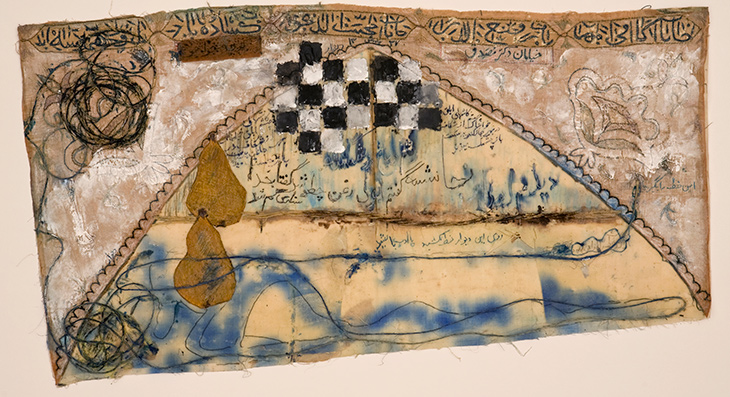
Wall (1958), Siah Armajani. Photo: Larry Marcus. Courtesy the artist
Situated in the American Midwest, Armajani occasionally aligned with the artistic zeitgeist, but was more often free to pursue idiosyncratic interests. His earliest American works, such as Two Dimensional Dictionary of Things and Non Things of 1960, in which Armajani pasted every illustration from a Webster’s Dictionary on to canvas and blacked out the text, signal an end to his Farsi-inflected paintings. At the same time, however, he was discovering a new language in the form of computer-programming code. Works from this period include a programme for a tower that would cast a shadow over the state of North Dakota and the massive pile of computer print-outs that is A Number Between 0 and 1 (1969), on view at the Met Breuer encased in a nine-foot-high steel column. Presented together, Armajani’s works from his first decade in the US reveal an artist occupied by both the losses of exile and the exuberant discovery of arrival.
Beginning in 1968, Armajani turned to architecture, attracted by its broad social function. A model for his first full-scale construction, First Bridge, shows a covered, wooden bridge with a square entrance that tapers to a small, confined window, so that anyone who enters must stoop, duck and crouch, before eventually turning back. Between 1974 and 1975, Armajani produced thousands of maquettes of domestic objects in his Dictionary for Building, made from cardboard and wood, ranging from creations as sensible as Radiator Under Window to otherworldly scenes like Door Above Door. More than a hundred of these models are displayed on tables in the exhibition, providing a near-complete picture of the artist-as-lexicographer, obsessively indexing his new spatial vocabulary.
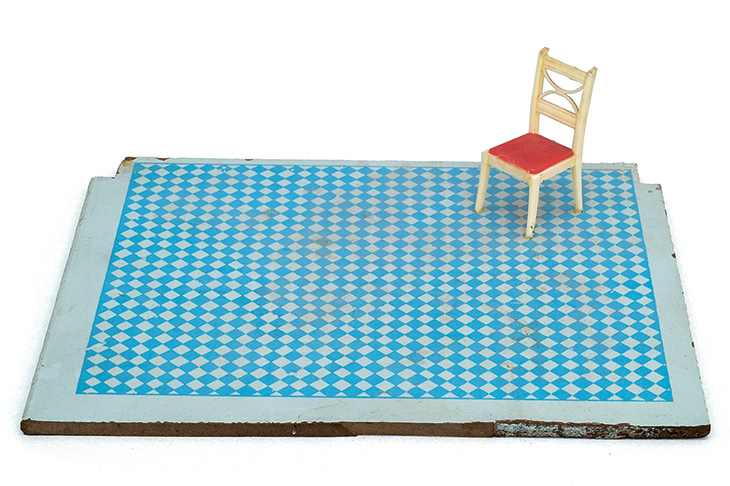
Dictionary for Building: Back Yard (1974–75), Siah Armajani. Collection MAMCO, Geneva. Courtesy the artist
Unlike those of other language-oriented conceptual artists, Armajani’s words are not only meant to be seen, like advertisements (as in Ed Ruscha’s ‘word paintings’ or Lawrence Weiner’s pithy slogans), but to be read. One full-scale construction at the Met Breuer is the Sacco and Vanzetti Reading Room #3 (1988), named after the wrongfully executed Italian-American anarchists, in which visitors can peruse a selection of texts chosen by the Slavs and Tatars artists collective. ‘Public sculpture attempts to demystify art,’ writes Armajani in his manifesto, making ‘artists citizens again’.
An exiled artist, whose displacement was caused largely by American intervention, Armajani has nonetheless been deeply invested in the idea of American democracy. Although he was also influenced by Heidegger, Wittgenstein, and Russian Constructivism, the majority of his references are to poets and thinkers in the radical-democratic tradition of Henry David Thoreau, Walt Whitman, Emma Goldman, and John Dewey, often quoted directly in his pieces or memorialised in sepulchral sculptures. More recent installations, however, address American culture’s divergence from these ideals, as in a series of rooms designed as resting places for deportees and Fallujah, a three-dimensional, glass-and-metal adaptation of Picasso’s Guernica dedicated to the Iraqi city, censored in the US when it first appeared in 2004. In 2000, Armajani announced that he would no longer create habitable structures and would instead cage them in glass, quoting Adorno’s statement that ‘it is part of morality not to be at home in one’s home’.
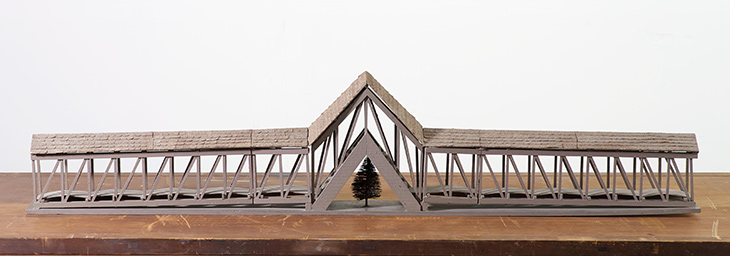
Model for Bridge over Tree (1970), Siah Armajani. Courtesy the artist
After the exhibition closes, one of Armajani’s full-scale installations will be visible for a few months more, in Brooklyn Bridge Park. Bridge Over Tree, a restaging of a 1970 installation, is a largely unassuming structure, shingle-roofed and made of greyish-white wood, save for a dramatic rupture over a single evergreen tree. It’s awe-inspiring in its humility, a vision of the subjection of human effort to natural will. The bridge will be dismantled in September, but the tree will remain.
‘Siah Armajani: Follow This Line’ is at the Met Breuer, New York, until 2 June.
Unlimited access from just $16 every 3 months
Subscribe to get unlimited and exclusive access to the top art stories, interviews and exhibition reviews.

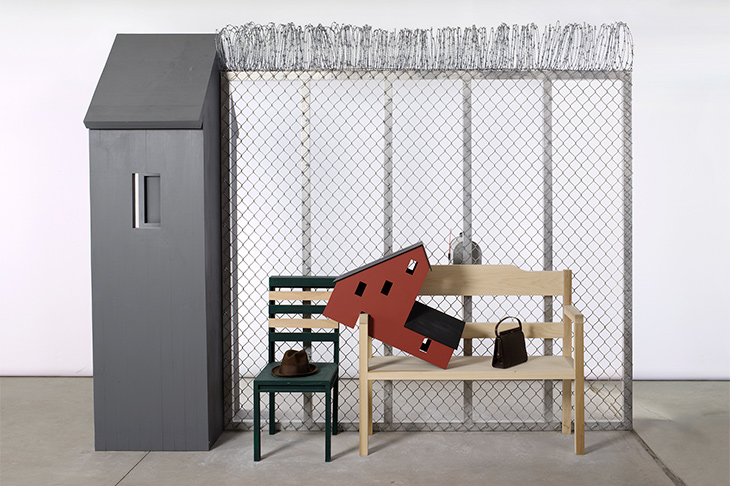
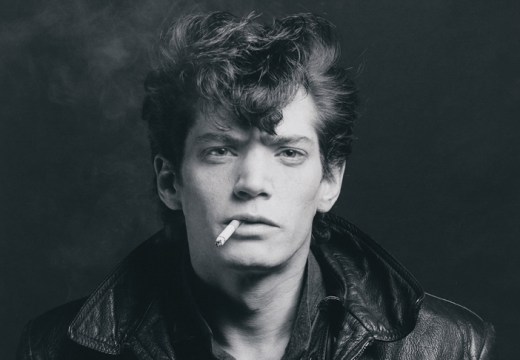
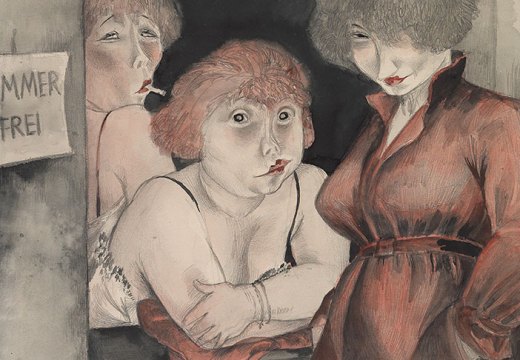
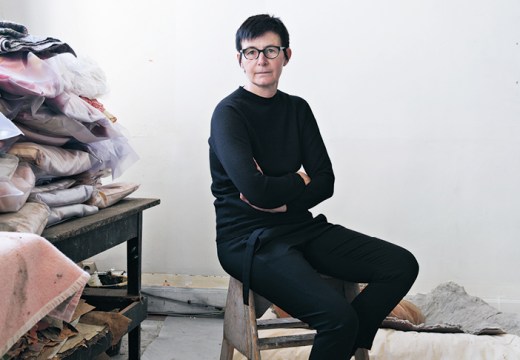









![Masterpiece [Re]discovery 2022. Photo: Ben Fisher Photography, courtesy of Masterpiece London](http://www.apollo-magazine.com/wp-content/uploads/2022/07/MPL2022_4263.jpg)
It’s time for the government of London to return to its rightful home